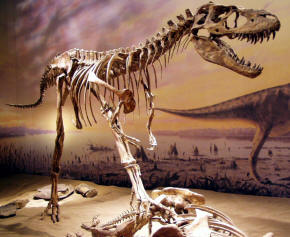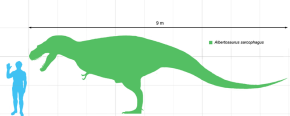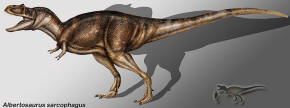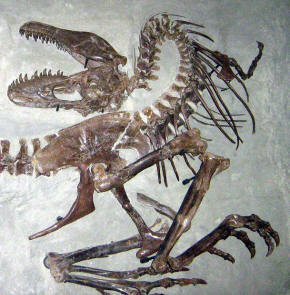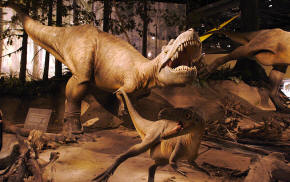|
Since the first discovery in 1884,
fossils of more than thirty individuals have been recovered, providing
scientists with a more detailed knowledge of
Albertosaurus anatomy than is available for most
other tyrannosaurids. The discovery of 22 individuals at one site provides
evidence of
pack behavior and
allows studies of
ontogeny and
population biology
which are impossible with lesser-known dinosaurs.
Description
Albertosaurus
was smaller than the truly gigantic tyrannosaurids like
Tarbosaurus and
Tyrannosaurus. Typical
adults measured up to 9 meters (30 ft) long,
while rare individuals of great age could grow to over 10 meters (33 ft) in
length. Several independent mass estimates,
obtained by different methods, suggest that an adult
Albertosaurus weighed
between 1.3 tonnes
(1.4 short
tons) and 1.7 tonnes (1.9 tons).
The massive skull of
Albertosaurus, perched on
a short, S-shaped
neck, was approximately 1 meter (3.3 ft) long in the largest adults.
Wide openings in the skull (fenestrae)
reduced the weight of the head while also providing space for muscle attachment and
sensory organs. Its
long jaws contained more than 60 banana-shaped teeth;
larger tyrannosaurids possessed fewer teeth. Unlike most theropods,
Albertosaurus and other
tyrannosaurids were
heterodont, with teeth
of different forms depending on their position in the mouth. The
premaxillary teeth at
the tip of the upper jaw were much smaller than the rest, more closely
packed, and D-shaped
in
cross section. Above
the eyes were short bony crests that may have been brightly colored in life
and used in courtship to attract a mate.
All tyrannosaurids, including
Albertosaurus, shared a
similar body appearance. Typically for a theropod,
Albertosaurus was bipedal
and balanced the heavy head and torso with a long tail.
However, tyrannosaurid forelimbs were extremely small for their body size
and retained only two digits. The hind limbs were long and ended in a
four-toed foot. The first digit, called the
hallux, was short and
only the other three contacted the ground, with the third (middle) digit
longer than the rest. Albertosaurus
may have been able to reach speeds of 14−21 kilometers per hour (8−13 miles
per hour).
Classification and Systematics
Cladogram
of Tyrannosauridae highlighting the position of
Albertosaurus
|
Tyrannosauridae
|
|
|
Tyrannosaurinae
|
|
|
|
Albertosaurinae
|
|
|
Albertosaurus
|
|
|
|
|
Gorgosaurus
|
|
|
|
|
|
|
|
|
|
Albertosaurus
is a member of the theropod family Tyrannosauridae,
in the subfamily Albertosaurinae. Its closest relative is the slightly older
Gorgosaurus libratus
(sometimes called Albertosaurus libratus;
see below). These two species are the only
described albertosaurines, although other undescribed species may exist.
The other major subfamily of
tyrannosaurids is the Tyrannosaurinae, including
Daspletosaurus,
Tarbosaurus and
Tyrannosaurus. Compared
with these robust tyrannosaurines, albertosaurines had slender builds, with
proportionately smaller skulls and longer bones of the lower leg (tibia)
and feet (metatarsals
and phalanges).
Discovery and Naming
Naming
Albertosaurus
was named by
Henry Fairfield Osborn
in a one-page note at the end of his 1905 description of
Tyrannosaurus rex.
The name honors
Alberta, the Canadian province in
which the first remains were found. The generic name also incorporates the
Greek term
σαυρος/sauros
("lizard"), the most common suffix in dinosaur names. The type species is
A. sarcophagus,
which means "flesh-eater" and has the same
etymology as the
funeral container with
which it shares its name: a combination of the Ancient Greek words
σαρξ/sarx
("flesh") and Φαγειν/phagein
("to eat"). More than thirty specimens of all
ages are known to science.
Early Discoveries
The
type specimen is a
partial skull, collected in 1884 from an
outcrop of the
Horseshoe Canyon Formation
alongside the
Red Deer River in
Alberta. This specimen and a smaller skull associated with some skeletal
material were recovered by expeditions of the
Geological Survey of Canada,
led by the famous
geologist
Joseph B. Tyrrell. The
two skulls were assigned to the preexisting species "Laelaps incrassatus" by
Edward Drinker Cope in
1892, despite the fact that the name
Laelaps was
preoccupied by a genus
of
mite and had been
changed to
Dryptosaurus in 1877
by
Othniel Charles Marsh.
Cope refused to recognize the new name created by his archrival Marsh, so it
fell to
Lawrence Lambe to
change "Laelaps incrassatus" to Dryptosaurus
incrassatus when he described the remains in
detail in 1904.
Shortly later, Osborn pointed out that D.
incrassatus was based on generic tyrannosaurid
teeth, so the two Alberta skulls could not be confidently referred to that
species. The Alberta skulls also differed markedly from the remains of
D. aquilunguis,
type species of Dryptosaurus,
so Osborn created the new name Albertosaurus
sarcophagus for them in 1905. He did not
describe the remains in any great detail, citing Lambe's complete
description the year before. Both specimens (CMN
5600 and 5601) are stored in the
Canadian Museum of Nature
in
Ottawa.
Dry Island Bonebed
In 1910, American paleontologist
Barnum Brown uncovered
the remains of a large group of Albertosaurus
at another
quarry alongside the
Red Deer River. Because of the large number of bones and the limited time
available, Brown's party did not collect every specimen, but made sure to
collect remains from all of the individuals they could identify in the
bonebed. Among the
bones deposited in the
American Museum of Natural History
collections in
New York City are seven
sets of right metatarsals, along with
two isolated toe bones that did not match any of the metatarsals in size.
This indicated the presence of at least nine individuals in the quarry. The
Royal Tyrrell Museum of Palaeontology
rediscovered the bonebed in 1997 and resumed fieldwork at the site, which is
now located inside
Dry Island Buffalo Jump Provincial Park.
Further excavation from 1997 to 2005 turned up the remains of 13 more
individuals of various ages, including a diminutive two-year-old and a very
old individual estimated at over 10 meters (33 ft) in length. None of these
individuals are known from complete skeletons, and most are represented by
remains in both museums.
Gorgosaurus libratus
In 1913, paleontologist
Charles H. Sternberg
recovered another tyrannosaurid skeleton from the slightly older
Dinosaur Park Formation
in Alberta. Lawrence Lambe named this dinosaur
Gorgosaurus libratus
in 1914. Other specimens were later found in
Alberta and
Montana. Finding few
differences to separate the two genera,
Dale Russell declared
the name Gorgosaurus
a
junior synonym of
Albertosaurus,
which had been named first, and G. libratus
was renamed Albertosaurus libratus
in 1970. This addition extended the temporal range of the genus
Albertosaurus backwards by
several million years and its geographic range southwards by hundreds of
kilometers.
In 2003,
Philip J. Currie
compared several tyrannosaurid skulls and came to the conclusion that the
two species are more distinct than previously thought. The decision to use
one or two genera is rather arbitrary, as the two species are
sister taxa, more
closely related to each other than to any other species. Recognizing this,
Currie nevertheless recommended that
Albertosaurus and
Gorgosaurus be retained as separate genera, as
they are no more similar than Daspletosaurus
and Tyrannosaurus,
which are almost always separated. In addition, several albertosaurine
specimens have been recovered from
Alaska and
New Mexico, and Currie
suggested that the Albertosaurus-Gorgosaurus
situation may be clarified once these are described fully.
Most authors have followed Currie's recommendation,
but some have not.
Other Discoveries
William Parks described
a new species, Albertosaurus arctunguis,
based on a partial skeleton excavated near the Red Deer River in 1928,
but this species has been considered identical to
A. sarcophagus since 1970.
Parks' specimen (ROM 807) is housed in the
Royal Ontario Museum in
Toronto. Six more
skulls and skeletons have since been discovered in Alberta and are housed in
various Canadian museums. Fossils have also been reported from the American
states of Montana, New Mexico, and Wyoming, but these
probably do not represent
A. sarcophagus
and may not even belong to the genus
Albertosaurus.
Albertosaurus megagracilis
was based on a small tyrannosaurid skeleton from the
Hell Creek Formation of
Montana. It was renamed
Dinotyrannus in 1995,
but is now thought to represent a juvenile
Tyrannosaurus rex.
Paleobiology
Growth Pattern
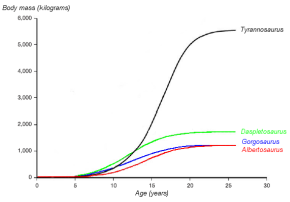 |
| A graph showing the hypothesized growth curves (body mass versus
age) of four tyrannosaurids, with Albertosaurus drawn in red |
Most age categories of
Albertosaurus are
represented in the fossil record. Using
bone
histology, the age of
an individual animal at the time of death can often be determined, allowing
growth rates to be estimated and compared with other species. The youngest
known Albertosaurus
is a two-year-old discovered in the Dry Island bonebed, which would have
weighed about 50 kilograms (110 lb)
and measured slightly more than 2 meters (7 ft) in length. The 10 meter
(33 ft) specimen from the same quarry is the oldest and largest known, at 28
years of age. When specimens of intermediate age and size are plotted on a
graph, an S-shaped
growth curve results, with the most rapid growth occurring in a four-year
period ending around the sixteenth year of life, a pattern also seen in
other tyrannosaurids. The growth rate during this phase was 122 kilograms
(268 lb) per year, based on an adult 1.3 tonnes
(1.4 short
tons). Other studies have suggested higher
adult weights; this would affect the magnitude of the growth rate but not
the overall pattern. Tyrannosaurids similar in size to
Albertosaurus had similar
growth rates, although the much larger
Tyrannosaurus rex grew almost five times faster
(601 kilograms [1325 lb] per year) at its peak.
The end of the rapid growth phase suggests the onset of sexual maturity in
Albertosaurus,
although growth continued at a slower rate throughout the animals' lives.
Sexual maturation while still actively growing appears to be a shared trait
among small and large
dinosaurs as well as in large mammals such as humans and elephants. This pattern
of relatively early sexual maturation differs strikingly from the pattern in
birds, which delay their sexual maturity until after they have finished
growing.
Life History
Most known
Albertosaurus individuals
were aged 14 years or more at the time of death. Juvenile animals are rarely
found as fossils for several reasons, mainly preservation bias,
where the smaller bones of younger animals were less likely to preserved by
fossilization than the larger bones of adults, and collection bias, where
smaller fossils are less likely to be noticed by collectors in the field.
Young Albertosaurus
are relatively large for juvenile animals, but their remains are still rare
in the fossil record compared with adults. It has been suggested that this
phenomenon is a consequence of
life history, rather
than bias, and that fossils of juvenile
Albertosaurus are rare because they simply did
not die as often as adults did.
A hypothesis of
Albertosaurus life history
postulates that hatchlings died in
large numbers, but have not been preserved in the fossil record due to their
small size and fragile construction. After just two years, juveniles were
larger than any other predator in the region aside from adult
Albertosaurus, and more
fleet of foot than most of their prey animals. This resulted in a dramatic
decrease in their mortality rate and a corresponding rarity of fossil
remains. Mortality rates doubled at age twelve, perhaps the result of the
physiological demands of the rapid growth phase, and then doubled again with
the onset of sexual maturity between the ages of fourteen and sixteen. This
elevated mortality rate continued throughout adulthood, perhaps due to high
physiological demands, stress and injuries received during intraspecific
competition for mates and resources, and eventually, the ever-increasing
effects of
senescence. The higher
mortality rate in adults may explain their more common preservation. Very
large animals were rare because few individuals survived long enough to
attain such sizes. High infant mortality rates, followed by reduced
mortality among juveniles and a sudden increase in mortality after sexual
maturity, with very few animals reaching maximum size, is a pattern observed
in many modern large mammals, including elephants,
African buffalo, and
rhinoceros. The same
pattern is also seen in other tyrannosaurids. The comparison with modern
animals and other tyrannosaurids lends support to this life history
hypothesis, but bias in the fossil record may still play a large role,
especially since more than two-thirds of all
Albertosaurus specimens are known from one
locality.
In 2009, researchers hypothesized
that smooth-edged holes found in the fossil jaws of tyrannosaurid dinosaurs
such as
Albertosaurus
were caused by a parasite similar to
Trichomonas gallinae
which infects birds. They suggested that
tyrannosaurids transmitted the infection by biting each other, and that the
infection impaired their ability to eat food.
Pack Behavior
The Dry Island bonebed discovered by
Barnum Brown and his crew contains the remains of 22
Albertosaurus, the most
individuals found in one locality of any Cretaceous theropod, and the
second-most of any large theropod dinosaur behind the
Allosaurus assemblage
at the
Cleveland Lloyd Dinosaur Quarry
in Utah. The group seems
to be composed of one very old adult; eight adults between 17 and 23 years
old; seven sub-adults undergoing their rapid growth phases at between 12 and
16 years old; and six juveniles between the ages of 2 and 11 years, who had
not yet reached the growth phase.
The near-absence of herbivore remains and
the similar state of preservation between the many individuals at the
Albertosaurus bonebed
quarry led Currie to conclude that the locality was not a predator trap like
the
La Brea Tar Pits in
California, and that
all of the preserved animals died at the same time. Currie claims this as
evidence of pack behavior. Other scientists are
skeptical, observing that the animals may have been driven together by
drought, flood or for other reasons.
There is abundant evidence for
gregarious behavior among herbivorous dinosaurs, including ceratopsians and hadrosaurs. However,
only rarely are so many dinosaurian predators found at the same site. Small
theropods like
Deinonychus,
Coelophysis and
Megapnosaurus (Syntarsus) rhodesiensis
have been found in aggregations, as have larger predators like
Allosaurus and
Mapusaurus. There is
some evidence of gregarious behavior in other tyrannosaurids as well.
Fragmentary remains of smaller individuals were found alongside "Sue," the
Tyrannosaurus
mounted in the
Field Museum of Natural History
in
Chicago, and a bonebed
in the
Two Medicine Formation
of Montana contains at least three specimens of
Daspletosaurus, preserved
alongside several hadrosaurs. These findings may
corroborate the evidence for social behavior in
Albertosaurus, although
some or all of the above localities may represent temporary or unnatural
aggregations. Others have speculated that
instead of social groups, at least some of these finds represent Komodo dragon-like
mobbing of carcasses, where aggressive competition leads to some of the
predators being killed and cannibalized.
Currie also offers speculation on
the pack-hunting habits of Albertosaurus.
The leg proportions of the smaller individuals were comparable to those of
ornithomimids, which
were probably among the fastest dinosaurs. Younger
Albertosaurus were
probably equally fleet-footed, or at least faster than their prey. Currie
hypothesized that the younger members of the pack may have been responsible
for driving their prey towards the adults, who were larger and more
powerful, but also slower. Juveniles may also
have had different lifestyles than adults, filling predator
niches between the
enormous adults and the smaller contemporaneous theropods, the largest of
which were two orders of magnitude
smaller than adult
Albertosaurus
in mass. A similar situation is observed in
modern Komodo dragons, with hatchlings beginning life as small
insectivores before
growing to become the dominant predators on their islands.
However, as the preservation of behavior in the fossil record is exceedingly
rare, these ideas cannot readily be tested.
Paleoecology
All identifiable fossils of
Albertosaurus sarcophagus
are known from the
Horseshoe Canyon Formation
in Alberta. This geologic formation
dates to the early
Maastrichtian stage of
the Late Cretaceous Period,
73 to 70 Ma (million years ago).
Immediately below this formation is the
Bearpaw Shale, a marine formation
representing a section of the
Western Interior Seaway.
The seaway was receding as the climate cooled and sea levels subsided
towards the end of the Cretaceous, exposing land that had previously been
underwater. It was not a smooth process, however, and the seaway would
periodically rise to cover parts of the region throughout Horseshoe Canyon
times before finally receding altogether in the years after. Due to the
changing sea levels, many different environments are represented in the
Horseshoe Canyon Formation, including offshore and near-shore marine
habitats and coastal habitats like
lagoons,
estuaries and
tidal flats. Numerous
coal seams represent
ancient
peat
swamps. Like most of
the other vertebrate fossils from
the formation,
Albertosaurus
remains are found in deposits laid down in the
deltas and
floodplains of large
rivers during the later half of Horseshoe Canyon times.
Dinosaurs dominate the fauna, especially hadrosaurs, which make up half of
all dinosaurs known, including the genera
Edmontosaurus,
Saurolophus and
Hypacrosaurus.
Ceratopsians and
ornithomimids were also
very common, together making up another third of the known fauna. Along with
much rarer
Ankylosaurians and
pachycephalosaurs, all
of these animals would have been prey for a diverse array of carnivorous
theropods, including
troodontids,
dromaeosaurids, and
caenagnathids. Adult
Albertosaurus were
the
apex predators in this
environment, with intermediate niches possibly filled by juvenile
albertosaurs.
Return to the
Old Earth Ministries Online Dinosaur
Curriculum homepage.

Shopping
Bay
State Replicas - Albertosaurus half-skull, Arm and Hand, Foot,
|
